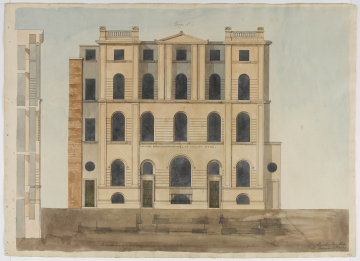
Browse
Reference number
Purpose
Aspect
Scale
Inscribed
Signed and dated
- Lincolns Inn Fields / November 6th 1817
Medium and dimensions
Hand
Notes
However, SM 48/2/31 (design C1) has a dividing line down the centre of the drawing, on either side of which are alternative treatments for the string-courses, the addition of sunk panels above the windows of the ground and first floors (right-hand side), the position of the fascias inscribed 'National Debt Redemption and Life Annuity Office' and the arrangement of two tiers of panel pilasters on the left-hand side and three tiers on the right-hand side. Omitted are the door and circular window of the projection on the right-hand side shown on this drawing, SM 48/2/24 and SM 48/2/4. The surround to a window on the right-hand bay of the second floor has been erased and the slight pencil part-elevation to the right of this has a note 'leave this window'.
The drawing shown here shares the same design as SM 48/2/24 (C2). The varying treatment of the string-courses has been resolved so that the simpler design with slender, elongated tablets under each window has been chosen, there are no sunk panels and the panel pilasters are in two tiers. The perspective drawing (SM 48/2/4) (C3) has the panel pilasters arranged in three tiers, the outer windows of the second floor have moulded surrounds with cornices and sunk panels have been added above the heads of the outer windows of the ground and first floors. The perspective shows the front (Old Jewry) and side (Meeting House Court) of the proposed new building in a setting of brick built three- and four-storey houses with ground floor shops.
Level
Sir John Soane's collection includes some 30,000 architectural, design and topographical drawings which is a very important resource for scholars worldwide. His was the first architect’s collection to attempt to preserve the best in design for the architectural profession in the future, and it did so by assembling as exemplars surviving drawings by great Renaissance masters and by the leading architects in Britain in the 17th and 18th centuries and his near contemporaries such as Sir William Chambers, Robert Adam and George Dance the Younger. These drawings sit side by side with 9,000 drawings in Soane’s own hand or those of the pupils in his office, covering his early work as a student, his time in Italy and the drawings produced in the course of his architectural practice from 1780 until the 1830s.
Browse (via the vertical menu to the left) and search results for Drawings include a mixture of Concise catalogue records – drawn from an outline list of the collection – and fuller records where drawings have been catalogued in more detail (an ongoing process).

